Exploring the potential danger that hydrangeas pose to our feline companions unveils a critical aspect of pet safety often overlooked. The toxic components within these seemingly innocuous plants can trigger severe repercussions if ingested by cats.
By understanding the implications of hydrangea toxicity and the necessary precautions to prevent harm, pet owners can ensure a secure environment for their cherished furballs.
Stay tuned to uncover the essential insights on safeguarding your cat from the potential risks associated with hydrangeas and discover effective strategies to maintain their well-being and happiness.
Key Takeaways
- Hydrangeas are toxic to cats due to amygdalin, which metabolizes into cyanide.
- Symptoms of hydrangea poisoning in cats include vomiting, diarrhea, lethargy, and stomach pain.
- Immediate veterinary care is crucial for diagnosis and treatment of hydrangea poisoning in cats.
- Prevention methods include limiting access to hydrangeas, using deterrents, and keeping pets indoors or in a catio.
Hydrangeas and Cats: Toxicity Facts
Hydrangeas pose a significant toxicity risk to cats due to the presence of amygdalin in all parts of the plant, with buds and young leaves containing higher concentrations of this toxic compound. This makes it crucial for pet owners to be vigilant in preventing their feline companions from accessing hydrangeas.
Ingestion of any part of the plant can lead to severe consequences for cats, as amygdalin metabolizes into cyanide when consumed. While cases of hydrangea poisoning in cats are rare due to the amount needed for severe effects, it is essential to prioritize the safety of our beloved pets by keeping them away from these beautiful yet dangerous plants.
Amygdalin in Hydrangeas: Toxic Effects
The presence of amygdalin in hydrangeas can have severe toxic effects on cats, necessitating a vigilant approach to pet safety around these plants. Amygdalin, a cyanogenic glycoside found in hydrangeas, can lead to cyanide poisoning when ingested by cats. The toxic effects of amygdalin on cats include gastrointestinal issues, difficulty breathing, and potential damage to vital organs. It is crucial for pet owners to recognize the dangers associated with hydrangeas and take proactive measures to prevent their cats from accessing these plants. Below is a table summarizing the toxic effects of amygdalin in hydrangeas on cats:
| Toxic Effects of Amygdalin in Hydrangeas on Cats |
|---|
| Gastrointestinal Issues |
| Difficulty Breathing |
| Organ Damage |
Symptoms of Hydrangea Poisoning in Cats
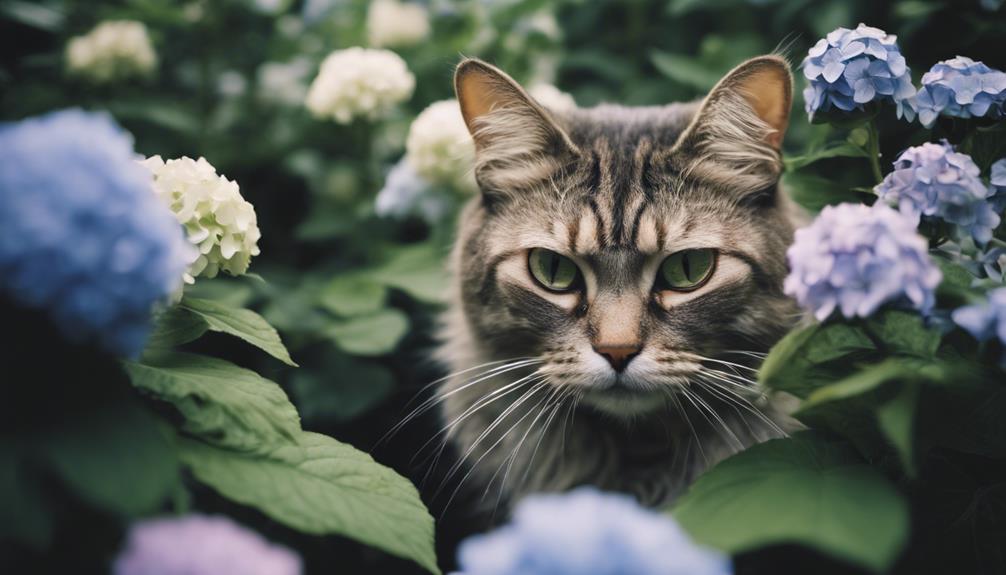
Symptoms indicative of hydrangea poisoning in cats can manifest quickly after ingestion of any part of the plant. Common signs include loss of appetite, lethargy, vomiting, diarrhea, and stomach pain. These symptoms typically appear within 30 minutes of ingestion and may vary in severity depending on the amount consumed.
It is crucial for cat owners to be vigilant and seek immediate veterinary care if they suspect their pet has ingested hydrangea. Prompt diagnosis and treatment are essential to prevent further complications. Inducing vomiting, providing fluids, and administering medication are common treatment methods.
After medical intervention, a bland diet can aid in the recovery process and help soothe the digestive system.
Hydrangea Poisoning Treatment for Cats
Prompt veterinary intervention is crucial in addressing cases of hydrangea poisoning in cats. If you suspect your cat has ingested hydrangea, seek immediate veterinary care.
The veterinarian will conduct a thorough examination to assess the severity of the poisoning. Treatment may include inducing vomiting to remove any remaining plant material from the stomach. Intravenous fluids are often administered to help flush out toxins and maintain hydration. Medications may be given to counteract the effects of the toxic compounds.
After the initial treatment, a bland diet may be recommended to aid in digestion and promote recovery. Monitoring your cat closely post-treatment is essential to ensure a full recovery and prevent any potential complications.
Preventing Hydrangea Poisoning in Pets
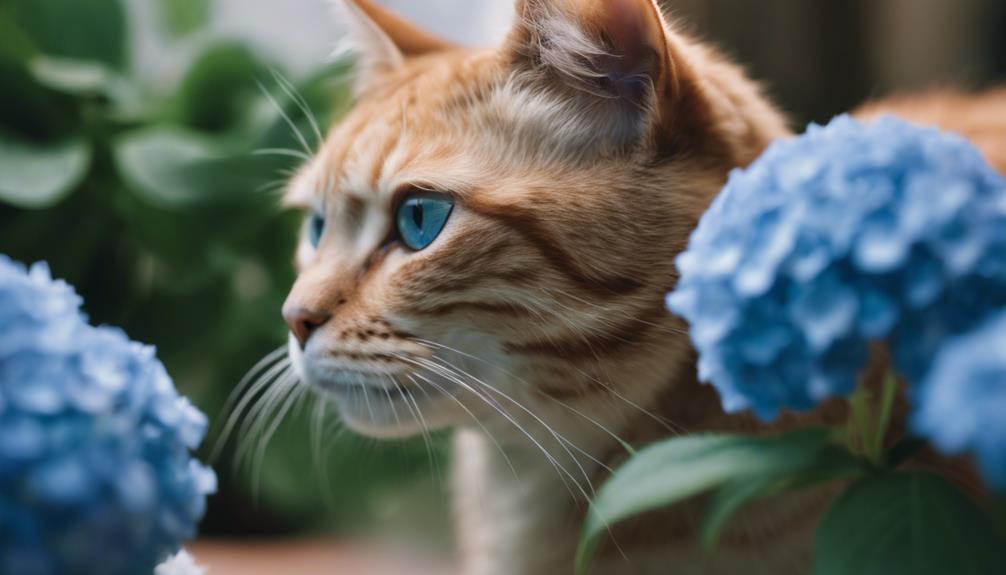
In light of the potential risks associated with hydrangea poisoning in pets, safeguarding your furry companions from exposure to toxic plants is paramount for their well-being and safety.
To prevent hydrangea poisoning in pets, consider the following tips:
- Make access to hydrangeas difficult for pets by using shells, branches, or thorny vines.
- Utilize non-toxic botanical oil sprays with noxious smells to deter animals.
- Install motion-activated sprinklers and ultrasonic deterrents, which can be effective in keeping pets away from toxic plants.
- Keep cats indoors or in a catio to prevent exposure to harmful plants.
- Regularly check your surroundings for any toxic plants and promptly remove them to create a safe environment for your beloved pets.
Strategies to Keep Pets Safe
For optimal pet safety and well-being, implementing proactive measures is essential in safeguarding your beloved companions from potential hazards. To keep your pets safe from toxic plants like hydrangeas, consider making these strategies part of your routine.
Limit access to dangerous plants by using physical barriers such as shells, branches, or thorny vines. Non-toxic botanical oil sprays with noxious scents can deter animals from exploring harmful flora. Motion-activated sprinklers and ultrasonic deterrents provide additional layers of protection.
If possible, keeping cats indoors or in a catio can prevent exposure to toxic plants altogether. By incorporating these strategies into your pet care regimen, you can create a safer environment for your furry friends.
Toxic Plants for Cats and Dogs
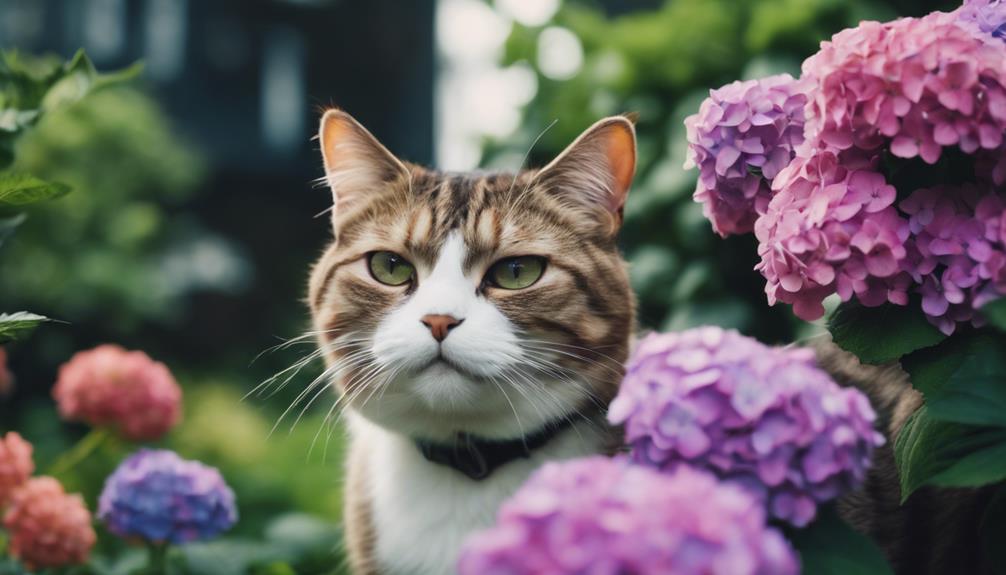
To safeguard the well-being of cats and dogs, it is crucial for pet owners to be aware of the various plants that can pose toxic threats to their beloved animals, including hydrangeas and other common flora.
Some plants to watch out for include:
- Hydrangeas: Contain amygdalin, which can metabolize into cyanide.
- Daisies and poinsettias: Toxic to cats.
- Lavender: Not entirely safe for dogs.
Immediate action is required if a pet ingests poisonous plants or foods. Prevention methods include making access difficult, using non-toxic botanical oil sprays, and keeping pets indoors or in a catio.
Deterrents for Pet Safety
Implementing effective deterrents is crucial for ensuring the safety and well-being of pets in their living environment. To protect your furry companions from toxic plants like hydrangeas, consider the following deterrent options:
| Deterrent | Description |
|---|---|
| Shells, Branches, Vines | Make hydrangeas less accessible using physical barriers such as shells, branches, or thorny vines. |
| Botanical Oil Sprays | Non-toxic sprays with strong scents can deter pets from approaching toxic plants like hydrangeas. |
| Motion-Activated Sprinklers | Sprinklers that activate when pets approach can startle them away from dangerous plants. |
| Ultrasonic Deterrents | Devices emitting high-frequency sound waves can deter pets from getting close to toxic plants. |
| Indoor Confinement | Keeping pets indoors or in a catio eliminates their exposure to potentially harmful plants like hydrangeas. |
Indoor Cat Safety Measures
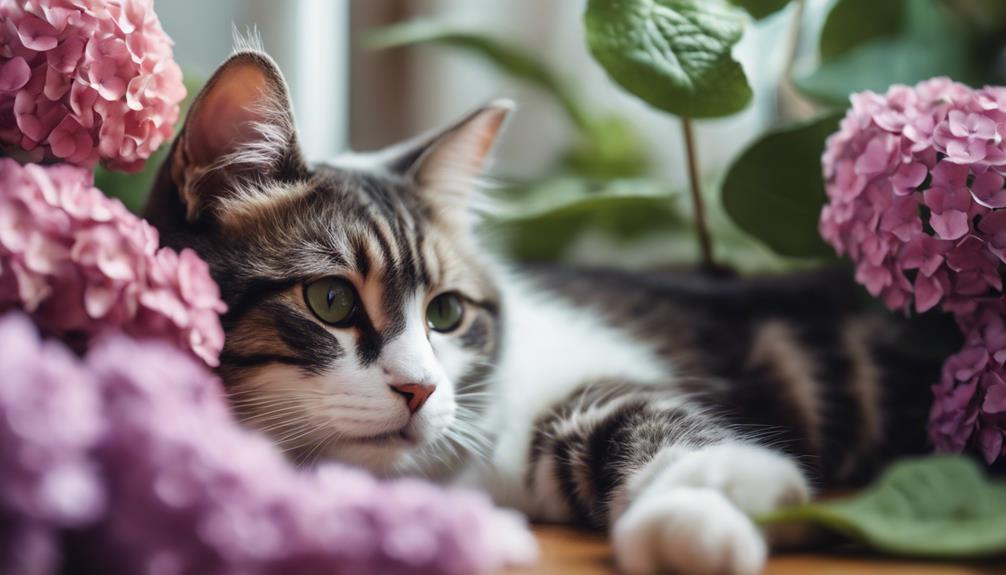
In light of the potential dangers posed by toxic plants like hydrangeas, safeguarding indoor cats requires meticulous attention to safety measures within their living environment. To ensure your furball's well-being, consider the following indoor cat safety measures:
- Secure all windows and balconies to prevent accidental falls.
- Remove small objects that could be swallowed or cause choking.
- Keep electrical cords hidden or secured to prevent chewing.
- Provide ample scratching posts and toys to satisfy natural behaviors.
- Create vertical spaces for climbing and perching to fulfill your cat's need for exploration and security.
Spring Pet Care Tips
As the spring season approaches, pet owners must prioritize the well-being and safety of their furry companions by implementing appropriate care measures. Spring can bring new challenges for pets, so here are some essential tips to ensure your furball stays happy and healthy:
| Spring Pet Care Tips | Description | Action |
|---|---|---|
| Grooming | Regular grooming helps remove loose fur and prevents matting. | Brush your pet frequently to maintain a healthy coat. |
| Flea and Tick Prevention | Use vet-approved products to protect your pet from parasites. | Apply flea and tick preventatives as recommended by your vet. |
| Outdoor Safety | Be cautious of plants, chemicals, and other hazards in the yard. | Supervise outdoor time and remove dangerous items from reach. |
| Allergy Awareness | Watch for signs of seasonal allergies like itching or sneezing. | Consult your vet if you suspect your pet has allergies. |
| Exercise Routine | Adjust exercise routines for longer daylight hours. | Enjoy outdoor activities with your pet but avoid overheating. |
Toxic Flowers for Pets
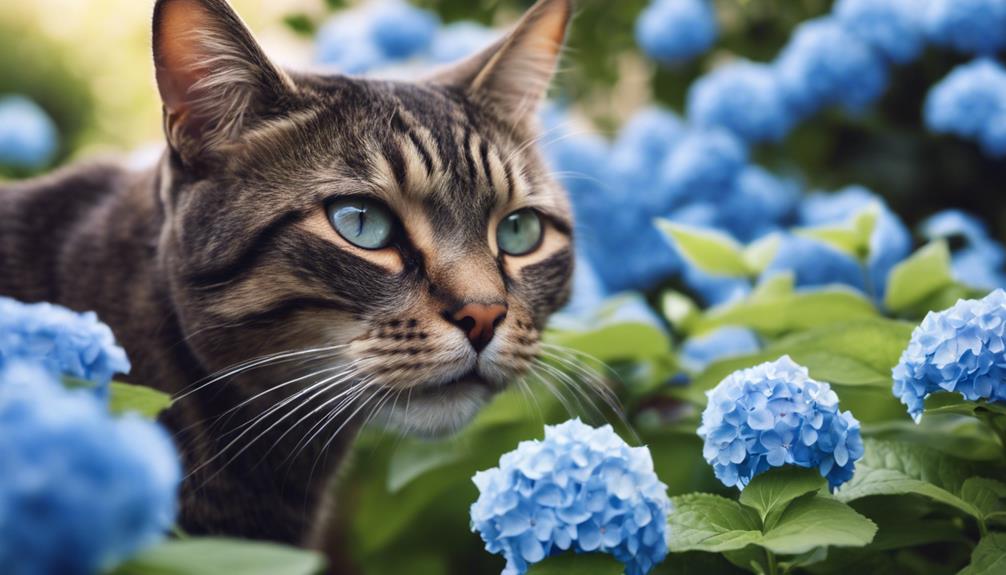
Ensuring the safety of your pets includes being aware of the potential dangers posed by toxic flowers, particularly those that can be harmful if ingested. Here are some common toxic flowers that pet owners should be cautious of:
- Lilies: Especially dangerous for cats, causing kidney failure.
- Tulips: Can cause gastrointestinal upset and even more severe symptoms.
- Oleander: Highly toxic to both cats and dogs, affecting the heart.
- Azaleas: Can lead to vomiting, diarrhea, and potentially more severe issues.
- Sago Palm: Extremely poisonous to pets, causing liver failure and possibly death.
Unsafe Plants for Cats
To safeguard your feline companions' well-being, it is crucial to be informed about plants that pose a threat to cats. Some common plants that are unsafe for cats include lilies, tulips, and oleander. These plants can cause various symptoms if ingested, ranging from gastrointestinal upset to more severe issues like kidney failure or even death. It's essential to keep these plants out of reach of your curious feline friends to prevent any potential harm. Here is a table highlighting these unsafe plants for cats:
| Unsafe Plants for Cats |
|---|
| Lilies |
| Tulips |
| Oleander |
Safe Gardening Practices
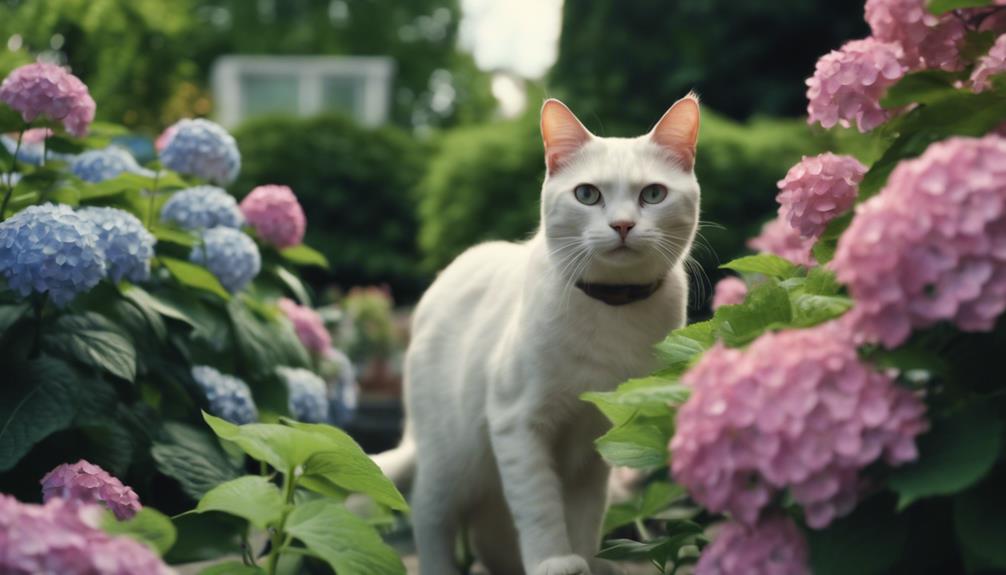
Practicing safe gardening techniques is paramount for protecting your pets from potentially harmful plants in your outdoor spaces. To ensure a pet-friendly garden environment, consider the following tips:
- Create barriers: Use shells, branches, or thorny vines to make access to toxic plants like hydrangeas difficult for pets.
- Utilize deterrents: Non-toxic botanical oil sprays with noxious smells can deter animals from approaching dangerous plants.
- Install devices: Motion-activated sprinklers and ultrasonic deterrents are effective tools to keep pets away from toxic plants.
- Limit outdoor access: Keeping cats indoors or in a secure catio enclosure is the best way to prevent plant poisoning incidents.
- Regular monitoring: Regularly inspect your garden for any new potentially toxic plants and promptly remove them to safeguard your pets.
Hydrangeas and Pet Health
How can the presence of hydrangeas in your surroundings impact the health of your pets?
Hydrangeas pose a significant risk to the well-being of your furry friends. These plants contain amygdalin, a toxic compound that can lead to severe health issues if ingested.
For cats, symptoms of hydrangea poisoning include loss of appetite, lethargy, vomiting, diarrhea, and stomach pain. Immediate veterinary attention is crucial to diagnose and treat any potential poisoning.
While cases of hydrangea poisoning in pets are rare due to the amount needed for severe effects, it's vital to take preventive measures. Ensuring limited access to hydrangeas through barriers and using deterrents can help safeguard your pets from accidental ingestion and potential harm.
Pet-Friendly Plant Alternatives
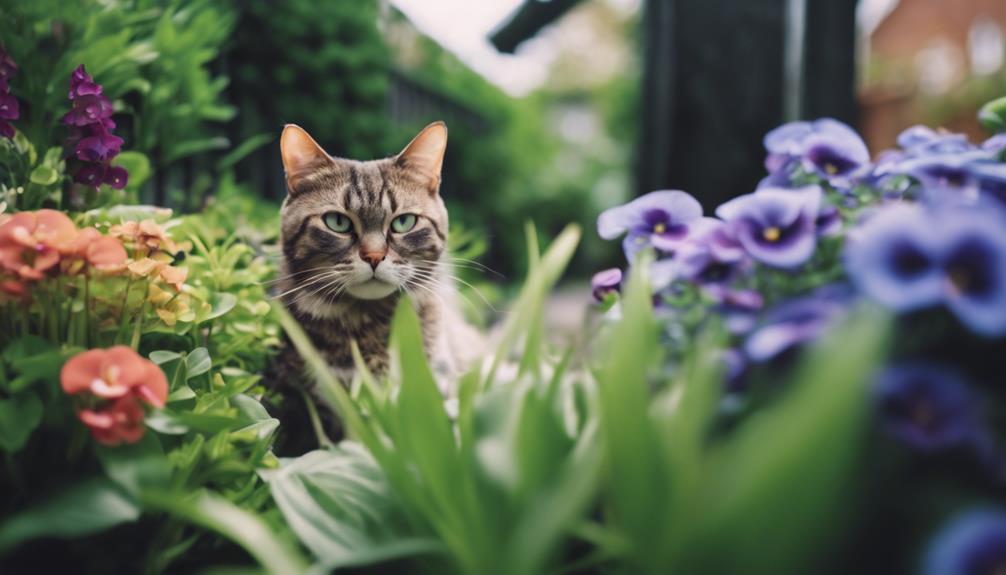
Considering the risks posed by toxic plants like hydrangeas to pets, exploring pet-friendly plant alternatives can help create a safe environment for your furry companions. When selecting plants for your home or garden, opt for options that are non-toxic to cats and dogs. Here are some pet-friendly alternatives to consider:
- Spider plants
- Boston ferns
- African violets
- Areca palms
- Blue echeveria
These plants not only add beauty to your space but also provide a safe and enriching environment for your pets. By incorporating these alternatives, you can enjoy a lush greenery without worrying about the potential dangers that toxic plants may pose to your beloved animals.
Frequently Asked Questions
Can Cats Become Ill From Hydrangeas by Simply Touching the Plant or Does Ingestion Need to Occur?
Cats can become ill from hydrangeas through ingestion as the toxic compound amygdalin found in all parts of the plant metabolizes into cyanide when ingested. Touching alone is unlikely to cause poisoning, but prevention is vital.
Are There Any Long-Term Health Effects on Cats if They Are Exposed to Hydrangeas but Do Not Show Immediate Symptoms?
Exposure to hydrangeas without immediate symptoms does not guarantee safety for cats. Long-term effects may manifest, necessitating veterinary care. Preventative measures, such as limiting access to toxic plants and swift action upon exposure, are crucial for pet safety.
Are There Any Specific Breeds of Cats That May Be More Sensitive to Hydrangea Poisoning Than Others?
Certain cat breeds, like Siamese or Burmese, may be more sensitive to hydrangea poisoning due to potential genetic variations in metabolizing toxins. However, all cats are susceptible, emphasizing the importance of keeping these plants out of reach.
Can the Toxic Effects of Hydrangeas on Cats Be Reversed With Prompt Veterinary Care, or Are There Lasting Consequences?
Prompt veterinary care can reverse the toxic effects of hydrangeas on cats, preventing lasting consequences. Symptoms like loss of appetite, vomiting, and diarrhea necessitate immediate treatment. Keeping hydrangeas inaccessible to pets and prompt medical attention are crucial.
Are There Any Natural Remedies or Home Treatments That Can Be Used to Alleviate Symptoms of Hydrangea Poisoning in Cats Before Seeking Veterinary Care?
When addressing hydrangea poisoning in cats, it is crucial to prioritize immediate veterinary care for proper diagnosis and treatment. While home remedies may seem appealing, professional intervention is the safest and most effective approach for your pet's well-being.
Conclusion
In conclusion, it is crucial to recognize the toxic nature of hydrangeas and the potential risks they pose to feline well-being. Understanding the symptoms, treatment options, and preventive measures associated with hydrangea poisoning in cats is essential for ensuring the safety and health of our beloved pets.
By being aware of unsafe plants, practicing safe gardening habits, and exploring pet-friendly plant alternatives, pet owners can create a secure environment that promotes the longevity and well-being of their furry companions.




